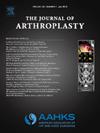胫骨近端后中央切片截骨术:用于矫正后稳定全膝关节置换术治疗曲张性骨关节炎的抵抗性紧缩伸展间隙的新技术。
IF 3.4
2区 医学
Q1 ORTHOPEDICS
引用次数: 0
摘要
背景:全膝关节置换术(TKA)的目的是消除膝关节晚期骨关节炎引起的疼痛,矫正肢体排列和生物力学,提高患者的生活质量。除了内外侧平衡外,平衡屈伸间隙也是取得良好效果的首要条件。本研究提出了一种新的胫骨近端后中央切片截骨术(PCSO-PT)手术技术,用于矫正后稳定膝(PS)的伸展间隙,并评估其临床和功能效果:一项前瞻性研究对2016年1月至2018年7月期间连续84例患有三室骨关节炎和膝关节屈曲畸形、需要在PS TKA期间进行胫骨近端PCSO的膝关节进行了研究。在术后至少两年内,定期对膝关节学会评分、屈曲畸形、活动范围、前后不稳定性和并发症进行评估:截骨术成功矫正了后关节囊松解术后小于11°的残余屈曲畸形。术前平均18.1 ± 2.5°的屈曲畸形在股骨端后囊松解术后改善至术中的8.6 ± 2.2°,截骨术后立即改善至术中的0.65 ± 0.76°,所有患者在术后6周均未发现残余屈曲畸形。TKA 术后,膝关节协会平均评分从术前的 32 ± 12 分显著提高到最终随访时的 94 ± 3 分,但这并没有负面影响。术前屈曲畸形与抗阻力、紧缩的伸展间隙之间存在直接关联(P = 0.003)。在整个随访期间,屈曲中期或活动时的冠状面或矢状面不稳定性没有增加,也没有发现任何重大不良反应:结论:胫骨近端后中央切片截骨术是股骨端关节囊松解后在TKA期间克服伸展过紧的有效且安全的替代方法,而不是从胫骨端或关节囊中部区域进行关节囊松解。本文章由计算机程序翻译,如有差异,请以英文原文为准。
Postero-Central Slice Osteotomy of the Proximal Tibia: A Novel Technique for Correcting Resistant Tight Extension Gaps in Posterior-Stabilized Total Knee Arthroplasty for Varus Osteoarthritis
Background
The aim of total knee arthroplasty (TKA) is to circumvent the pain due to advanced osteoarthritis of the knee joint and correct the limb alignment and biomechanics to improve patients’ quality of life. Apart from medio-lateral balancing, balancing flexion and extension gaps is a prerogative to achieve good results. This study proposes a novel surgical technique of postero-central slice osteotomy of the proximal tibia (PCSO-PT) for correcting tight extension gaps in posterior-stabilized knees and assesses its clinical and functional outcomes.
Methods
A prospective study was conducted on 84 consecutive knees with tricompartmental osteoarthritis and varus deformity, requiring PCSO-PT during posterior-stabilized TKA between January 2016 and July 2018. Knee Society scores, flexion deformity, range of motion, antero-posterior instability, and complications were assessed at regular intervals for a minimum of 2 years postoperatively.
Results
Residual flexion deformities less than 11° after posterior capsular release were successfully corrected by the osteotomy. The mean preoperative flexion deformity of 18.1 ± 2.5° improved to 8.6 ± 2.2° intraoperatively after posterior capsular release from the femoral end and to 0.65 ± 0.76° intraoperatively immediately after the osteotomy, with no residual flexion deformity noted in any patient 6 weeks postoperatively. It had no negative effect on the significant post-TKA improvement of the mean Knee Society score from 32 ± 12 preoperatively to 94 ± 3 at the terminal follow-up. A direct correlation between preoperative flexion deformity and a resistant, tight extension gap (P = 0.003) was noted. There was no increase in coronal plane or sagittal plane instabilities in midflexion or on mobilization throughout the follow-up period, nor were any major adverse effects noted in this period.
Conclusions
A PCSO-PT is an effective and safe alternative to overcoming tight extension during TKA after femoral-end capsular release, instead of capsular release from the tibial end or midcapsular region.
Level of evidence
Level IV, therapeutic study.
求助全文
通过发布文献求助,成功后即可免费获取论文全文。
去求助
来源期刊

Journal of Arthroplasty
医学-整形外科
CiteScore
7.00
自引率
20.00%
发文量
734
审稿时长
48 days
期刊介绍:
The Journal of Arthroplasty brings together the clinical and scientific foundations for joint replacement. This peer-reviewed journal publishes original research and manuscripts of the highest quality from all areas relating to joint replacement or the treatment of its complications, including those dealing with clinical series and experience, prosthetic design, biomechanics, biomaterials, metallurgy, biologic response to arthroplasty materials in vivo and in vitro.
 求助内容:
求助内容: 应助结果提醒方式:
应助结果提醒方式:


